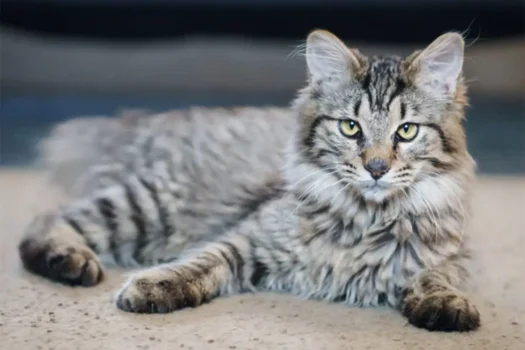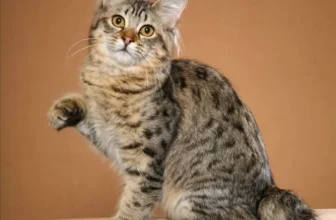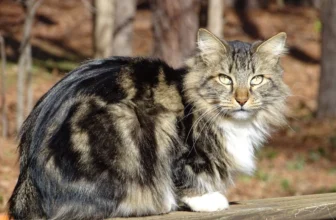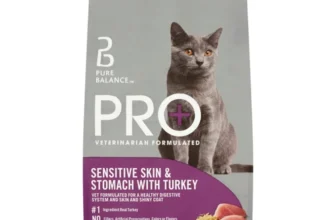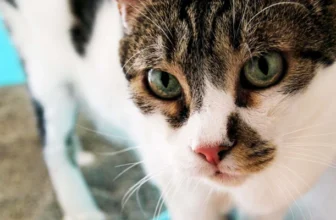As feline obesity rates continue to rise in the United States, it has become a growing concern among cat owners. American Bobtail cats, known for their adorable bobbed tails and playful personalities, are no exception to this trend. It can be perplexing and frustrating for owners to see their beloved pets struggling with weight issues. In this article, we will explore the potential causes of obesity in American Bobtail cats and provide practical tips for maintaining a healthy weight. So, grab a seat and let’s dive into this important topic for the health and happiness of your furry friend.
Causes of Obesity in American Bobtail Cats
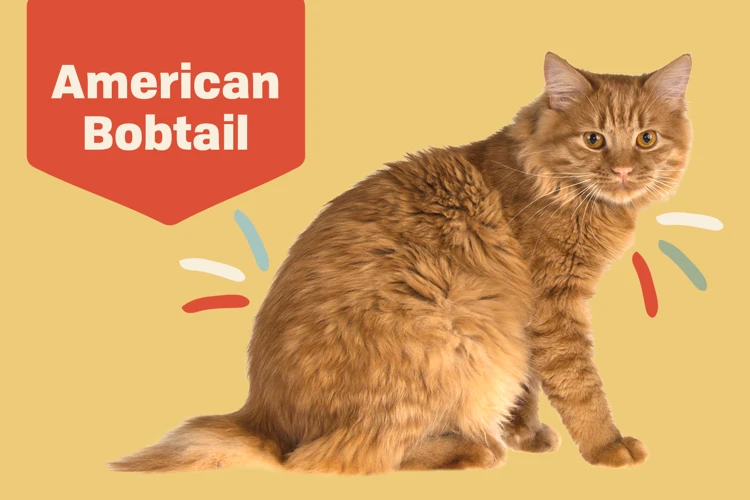
As much as we love our American Bobtail cats, it can be easy to mistakenly overfeed them or not prioritize their exercise needs, leading to the development of obesity. Obesity is a serious health concern for cats, and it can lead to a host of other health issues. In fact, according to recent studies, overweight cats are at a higher risk for health issues such as diabetes, joint problems, and heart disease. In this article, we will explore the various causes of obesity in American Bobtail cats such as overfeeding, genetics, and medical conditions, and discuss ways to prevent it. If you notice signs of obesity in your American Bobtail, such as a lack of energy, difficulty breathing or a reluctance to move, it’s crucial to seek help immediately. Stay with us to learn more about the causes, health risks, and steps to reduce the obesity in your furry friend.
1. Overfeeding and Free-Feeding
Overfeeding and free-feeding are common causes of obesity in American Bobtail cats. Although it may seem like a sign of love to give your furry friend a constant supply of food, this can quickly lead to weight gain and health issues. It’s important to understand the appropriate amount and frequency of food to keep your American Bobtail healthy.
Overfeeding occurs when you give your cat too much food at once or too often, which can cause them to consume more calories than they can burn off. This contributes to weight gain and obesity. It’s important to feed your cat the correct portion size based on their individual needs. Your vet can help you determine how much food your American Bobtail should be eating each day to maintain a healthy weight.
Free-feeding is when food is constantly available to your cat throughout the day. This can lead to overeating and obesity, as well as other health issues such as diabetes and dental problems. It’s important to establish set meal times and limit the amount of food available to your American Bobtail.
To prevent overfeeding and free-feeding, it’s important to establish a feeding routine and stick to it. Use measuring cups to ensure you are giving your cat the appropriate portion size each time. Additionally, avoid giving your cat too many treats or table scraps as these can also contribute to weight gain.
By taking steps to prevent overfeeding and free-feeding, you can help your American Bobtail maintain a healthy weight and avoid the health risks associated with obesity. For more information on how to prevent and reduce obesity in American Bobtail cats, check out our article on preventing obesity in American Bobtail cats.
2. Lack of Exercise
Lack of exercise is another major contributor to obesity in American Bobtail cats. These cats are naturally active and love to play, hunt, and explore. Without enough physical activity to burn off calories, the excess energy gets stored as fat. It’s important to ensure that your American Bobtail gets enough exercise to maintain a healthy weight.
Here are some possible reasons why your American Bobtail may not be getting enough exercise:
- Indoor confinement: Many cat owners keep their pets indoors to protect them from danger. However, indoor cats may not get as much exercise as those who can roam freely outside.
- Lack of playtime: If you don’t play with your cat regularly, they may turn to overeating as a form of entertainment. It’s important to spend time with your American Bobtail and engage them in activities that get them moving, such as chasing toys or batting at feather wands.
- Furniture and obstacles: If your home is cluttered with furniture or other obstacles, your cat may not have enough space to run and play. Make sure there are open areas where your cat can move around freely.
To help your American Bobtail get more exercise, consider these tips:
- Play with your cat: As mentioned, interactive playtime is a great way to get your cat moving. Try to play with your cat for at least 10-15 minutes each day using toys that encourage running and jumping.
- Encourage movement: Place toys and scratch posts in different areas of your home to encourage your cat to move around. You can also use puzzle toys that require your cat to work for their food.
- Outdoor time: If it’s safe and allowed in your area, you can take your cat outside on a leash or harness for supervised playtime. This can provide new sights and smells to stimulate your cat and encourage physical activity.
Remember, exercise is just as important for your American Bobtail’s health as a balanced diet. By providing ample opportunities for physical activity, you can help reduce their risk of obesity and associated health problems.
If you want to learn more about the health risks associated with obesity in American Bobtails, check out our article on Health Risks of Obesity in American Bobtails.
3. Genetics
When it comes to the causes of obesity in American Bobtail Cats, genetics can play a role. Just like humans, some cats may have a genetic predisposition to gaining weight more easily than others. According to studies, certain genes can affect a cat’s ability to burn fat and regulate appetite, which can lead to obesity if not properly managed.
However, it is important to note that genetics alone are not responsible for obesity in American Bobtail Cats. A combination of factors such as overfeeding, lack of exercise, and medical conditions can also contribute to weight gain.
To help manage obesity in American Bobtail Cats with a genetic predisposition, owners should work closely with their veterinarian to develop a customized diet and exercise plan.
- Limiting caloric intake is essential, but the diet should also be balanced to ensure that the cat receives all necessary nutrients.
- Interactive feeders and slow feeders can be used to promote a healthy eating pace and limit overeating.
- Exercise is key, even if the cat may be more prone to weight gain. Owners can engage their cats in active play, provide toys and climbing structures, and encourage brief bouts of physical activity throughout the day.
- Regular veterinary check-ups are important to monitor the cat’s weight and overall health, as well as to identify any potential medical conditions that may be contributing to weight gain.
By taking a proactive approach to managing obesity in American Bobtail Cats with a genetic predisposition, owners can help their cats maintain a healthy weight and avoid potential health complications. Remember, genetics may be a contributing factor, but there are still plenty of things that owners can do to reduce the risk of obesity in their furry friend.
For more information on obesity in American Bobtail Cats and how to reduce the risk, see our article on Obesity in American Bobtail Cats.
4. Age and Hormonal Changes
As American Bobtail cats age, their metabolism slows down, which makes it easier for them to gain weight even if their diet and activity levels stay the same. Additionally, hormonal changes can have an impact on their weight as well. For example, neutered or spayed cats are at a higher risk of obesity, as their altered hormonal balance can affect their metabolism and appetite control.
Senior cats are often less active, which can also contribute to their risk of obesity. As they age, cats may also develop certain medical conditions that can affect their weight, such as arthritis, diabetes, or thyroid disease. If you notice your American Bobtail is gaining weight as they age, it is important to schedule regular check-ups with your veterinarian to ensure there are no underlying health issues that could be contributing to their weight gain.
Hormonal changes can also make it more difficult for cats to maintain a healthy weight. For example, a condition called hyperthyroidism can cause cats to experience weight loss or gain, as well as other symptoms such as increased appetite and thirst. In contrast, cats with hypothyroidism may experience weight gain, lethargy, and a decreased metabolism.
While age and hormonal changes are factors that can contribute to obesity in American Bobtail cats, there are ways to help prevent or manage it. By focusing on a healthy diet, regular exercise, and scheduling regular check-ups with your veterinarian, you can help ensure your cat stays healthy throughout their life.
One effective strategy for managing age-related weight gain in cats is to provide them with a high-quality diet that meets their nutritional needs without going overboard on calories. Additionally, regularly weighing your cat and monitoring their body condition score can help you keep track of their weight and adjust their diet as needed.
If you suspect that your American Bobtail is struggling with obesity or a related health issue, it is important to consult with your veterinarian. They can provide guidance on the best course of action, which may include counseling on diet and exercise, prescribing medication, or recommending special diets to help your cat achieve and maintain a healthy weight.
Remember, obesity in cats can have serious consequences for their health and well-being, so it is important to take proactive steps to reduce the risk of obesity in your beloved furry companion.
If you want to learn more about the signs of obesity in American Bobtail cats, you can check out our article on obesity signs in American Bobtails. If your Bobtail is already overweight, you can find tips on how to help them reduce their weight or get exercise tips to help them stay active. Finally, don’t forget to schedule regular veterinary check-ups to ensure your cat stays healthy and happy.
5. Medical Conditions
Medical conditions can also contribute to obesity in American Bobtail cats. Some of these conditions include hypothyroidism, Cushing’s disease, and insulinoma, among others. These conditions can affect the cat’s metabolism and make it difficult for them to maintain a healthy weight.
Below is a table that outlines some medical conditions that can lead to obesity in cats:
| Medical Conditions | Description |
|---|---|
| Hypothyroidism | A condition where the thyroid gland doesn’t produce enough thyroid hormones. This can slow down a cat’s metabolism, leading to weight gain. |
| Cushing’s Disease | A condition where the adrenal glands produce too much cortisol. This can cause an increase in appetite and lead to weight gain. |
| Insulinoma | A condition where the pancreas produces too much insulin. This can cause blood sugar levels to drop, leading to an increase in appetite and weight gain. |
| Joint Problems | Cats with joint problems, such as arthritis, may find it difficult to move around and exercise. This can lead to weight gain and contribute to obesity. |
If you suspect that your American Bobtail has a medical condition that may be contributing to their weight gain, it is important to consult with your veterinarian. Your vet can perform tests to diagnose any underlying medical conditions, and develop a treatment plan to help your cat maintain a healthy weight.
How to Help Your American Bobtail Maintain a Healthy Weight
Many pet owners want to ensure their American Bobtail cats are healthy and happy. Maintaining a healthy weight is a key aspect of their overall wellbeing. Obesity can lead to a variety of health problems, including joint problems, diabetes and heart disease. Fortunately, there are several ways you can help your feline friend maintain a healthy weight. Here are some effective tips and strategies that can have a significant impact on your cat’s health and happiness.
1. Measure Meals
Maintaining a healthy weight is essential for American Bobtail cats to ensure that they live a long and healthy life. One of the primary causes of obesity in American Bobtail cats is overfeeding or free-feeding. As a responsible pet owner, it is important to measure your cat’s meals and ensure that they are getting the right amount of food each day.
Why measuring meals is important?
Free-feeding or overfeeding can lead to obesity, which increases the risk of other health problems such as diabetes, heart disease, and joint problems in American Bobtail cats. It is crucial to measure your cat’s food precisely, using either weighing scales or measuring cups.
How much to feed an American Bobtail cat?
The feeding requirements for American Bobtail cats vary depending on several factors, including age, weight, activity level, and overall health. It is recommended to feed them a balanced diet with a high amount of protein, which is suitable for their body weight and meets their nutritional needs.
Below is a table summarizing the recommended daily calorie intake for American Bobtail cats based on weight and activity level:
| Weight | Low Activity Level | Moderate Activity Level | High Activity Level |
|---|---|---|---|
| 8-10 pounds | 200-250 calories | 250-300 calories | 300-350 calories |
| 10-12 pounds | 250-300 calories | 300-350 calories | 350-400 calories |
| 12-14 pounds | 300-350 calories | 350-400 calories | 400-450 calories |
Please note that these are general guidelines, and it is essential to adjust your cat’s food intake according to their specific needs to maintain a healthy weight.
Conclusion
Measuring your American Bobtail cat’s meals is an effective way to ensure that they are getting the right amount of food each day. Overfeeding or free-feeding can lead to obesity, which can cause health problems. It is crucial to follow the recommended feeding guidelines, adjust the food intake according to their specific needs and to consult your veterinarian to help your American Bobtail cat achieve and maintain a healthy weight.
2. Use Interactive Feeders
Feline obesity is a serious issue that can lead to various health problems. One simple way to promote a healthy weight in American Bobtail cats is to use interactive feeders. These are special feeding bowls or puzzles that make mealtime more engaging, reduce eating speed and make portion control easier.
Interactive feeders come in many different shapes and sizes, but they all share the same goal: to encourage cats to eat more slowly and thoughtfully. By requiring the cat to work for their food, interactive feeders add some playfulness and stimulation to mealtime while also helping reduce the risk of overeating.
So, what types of interactive feeders are available for American Bobtail cats? Here are some common examples:
| Type of Interactive Feeder | Description |
|---|---|
| Maze Feeders | A bowl with a maze-like shape that forces the cat to nuzzle and search for their food. |
| Puzzle Toys | These toys can be filled with kibble, and the cat has to figure out how to get the kibble out of the toy. |
| Slow-Feeder Bowls | A simple, non-skid bowl with raised obstacles that separates food and reduces the eating speed of American Bobtail cats. |
| Lick Mats or Pads | These are flat mats with textures surface that can be used with wet or liquid food, encouraging the cat to lick their meals slowly and in small portions. |
Using interactive feeders can be a valuable tool for keeping your American Bobtail cat at a healthy weight. It is important to introduce interactive feeders gradually, as some cats may take some time to get used to them. While using an interactive feeder, it is important to monitor your cat’s eating behavior to ensure they are still eating enough to meet their nutritional needs. With some creativity and patience, interactive feeders can be a fun and useful way to manage your cat’s weight and well-being.
3. Encourage Exercise
Obesity in American Bobtail Cats can be caused by a variety of factors, including lack of exercise. It’s important to encourage your cat to be more active in order to maintain a healthy weight. Here are some ways you can do that:
- Schedule playtime: Set aside dedicated times during the day to play with your American Bobtail. Use toys that encourage running and jumping, such as laser pointers or feather wands.
- Provide vertical spaces: American Bobtails love to climb and perch. Consider adding a cat tree or shelving to your home to provide vertical spaces for your cat to explore and play on.
- Make mealtime active: Instead of feeding your cat from a bowl, use puzzle feeders or other interactive feeders that require your cat to “hunt” for their food. This will keep them mentally stimulated and physically active.
- Use positive reinforcement: When your American Bobtail is active and playful, praise and reward them with treats or affection. This will encourage them to continue being active.
Remember, every cat is different and some may require more or less exercise than others. Pay attention to your cat’s individual needs and abilities, and adjust their exercise routine accordingly. By making exercise a fun and regular part of your American Bobtail’s routine, you can help them maintain a healthy weight and live a happy, active life.
4. Seek Veterinary Care
Taking your American Bobtail cat for regular veterinary check-ups is an essential part of maintaining their overall health, including their weight. During a routine examination, your veterinarian can assess your cat’s body condition score (BCS) and let you know if they are at a healthy weight or if they need to lose some pounds.
In addition to determining if your cat is overweight or obese, your veterinarian can also rule out any underlying medical conditions that could be contributing to their weight gain. For example, medical issues such as hypothyroidism, Cushing’s disease, and insulin resistance can all lead to weight gain in cats. Your veterinarian can perform the necessary tests and screenings to diagnose and treat these conditions properly.
If your American Bobtail cat is already obese, your veterinarian can also provide you with specific diet and exercise recommendations to help your feline companion shed the excess weight. They may suggest a prescription weight-management diet or a customized feeding plan that takes into account your cat’s individual needs and lifestyle.
Your veterinarian can advise you on which types of physical activity are best suited for your cat, based on their age, breed, and overall health. They may recommend specific exercises, such as interactive play, to help your cat burn calories and build muscle.
Table: Benefits of Seeking Veterinary Care for Weight Management in American Bobtail Cats
| Benefits | Description |
| Early Detection of Medical Conditions | Your veterinarian can diagnose and treat underlying medical conditions that could be contributing to your cat’s weight gain. |
| Expert Advice | Your veterinarian can provide you with personalized recommendations for diet and exercise based on your cat’s individual needs and overall health. |
| Accountability | Your veterinarian can help you monitor your cat’s progress, adjust their weight management plan as needed, and hold you accountable for helping your cat maintain a healthy weight. |
| Prevention of Future Health Issues | Maintaining a healthy weight can prevent future health issues such as diabetes, arthritis, and heart disease, which are all more common in obese cats. |
Seeking veterinary care for your American Bobtail cat’s weight management is crucial for their overall health and well-being. Your veterinarian can diagnose and treat any underlying medical conditions, provide expert advice on diet and exercise, and help you monitor your cat’s progress towards a healthy weight. By working together with your veterinarian, you can help your cat live a long and healthy life.
5. Adjust the Diet as Needed
When it comes to maintaining a healthy weight in American Bobtail cats, adjusting their diet as needed is crucial. This means understanding the nutritional needs of your cat and making changes to their diet as they grow and age.
1. Consult with a Veterinarian
Before making any major changes to your cat’s diet, it’s important to consult with your veterinarian. They can help you determine the appropriate amount of food to feed your cat and recommend specific brands or types of food that will meet their nutritional needs.
2. Gradual Changes
If you do need to adjust your cat’s diet, it’s important to make changes gradually. Sudden changes in diet can be stressful for cats and may lead to gastrointestinal issues. Instead, make small adjustments over time until you reach the desired feeding amount or type of food.
3. Choose a High-Quality Food
When selecting food for your American Bobtail cat, it’s important to choose a high-quality cat food that meets their nutritional needs. Look for a food that has a high protein content and is specifically formulated for cats.
4. Monitor Your Cat’s Weight
To ensure your cat stays at a healthy weight, it’s important to monitor their weight over time. Check their weight regularly and adjust their diet as needed to maintain a healthy weight.
5. Address Any Medical Conditions
If your cat is struggling to maintain a healthy weight despite your efforts, it’s important to seek veterinary care. They can evaluate your cat for any underlying medical conditions that may be contributing to their weight issues and recommend appropriate treatment. Additionally, they may be able to recommend specific dietary changes that will help your cat maintain a healthy weight.
By adjusting your American Bobtail cat’s diet as needed and ensuring they receive regular veterinary care, you can help them maintain a healthy weight and live a long, happy life.
Conclusion
As a loving pet owner, maintaining your American Bobtail cat’s healthy weight should be a top priority. The causes of obesity in American Bobtails may include overfeeding, lack of exercise, genetics, age, hormonal changes, and underlying medical conditions.
To help your furry friend maintain a healthy weight, consider implementing a few changes to their lifestyle. Measuring their meals to avoid overfeeding and using interactive feeders to encourage physical activity while eating can significantly help. Encouraging exercise with playtime and toys is also important, as is seeking veterinary care if you suspect any medical issues may be contributing to your cat’s weight gain. Even adjusting their diet as needed can have a significant impact on their weight loss journey.
Remember, maintaining a healthy weight is important for your American Bobtail’s overall health and longevity. It can help prevent health issues such as joint problems, breathing difficulties, and diabetes. Our furry friends rely on us to provide them with the best possible care, and helping them maintain a healthy weight is one way we can do so. Implement these changes in your cat’s lifestyle, and watch them thrive and live long, healthy, and happy lives by your side.
Frequently Asked Questions
1. Can certain cat breeds be more prone to obesity?
Yes, some cat breeds have a higher predisposition to obesity, such as American Bobtail Cats.
2. Is dry cat food or wet cat food better for weight management?
Wet cat food is generally better for weight management as it tends to have fewer calories and is more filling than dry cat food.
3. Can neutered or spayed cats be more susceptible to obesity?
Yes, neutered or spayed cats are more prone to obesity due to changes in hormone levels that may affect their metabolism and appetite.
4. Are there any particular medical conditions that can cause obesity in cats?
Medical conditions such as hypothyroidism, diabetes, and Cushing’s disease can increase a cat’s risk of obesity.
5. Can feeding table scraps contribute to feline obesity?
Yes, feeding too many table scraps can contribute to feline obesity as they tend to be high in calories and may not meet a cat’s nutritional needs.
6. Why is it important to maintain a healthy weight for cats?
Maintaining a healthy weight can help prevent a range of health problems, such as diabetes, heart disease, and joint problems, and can improve a cat’s overall quality of life.
7. Can exercise alone help a cat lose weight?
No, while exercise is important for a cat’s overall health, weight loss typically requires a combination of exercise and calorie reduction.
8. How much should I feed my American Bobtail cat?
The amount of food an American Bobtail cat needs depends on their age, weight, and activity level. It’s best to consult with your veterinarian to determine the appropriate amount of food.
9. Are there any low-calorie snack options for cats?
Yes, there are some low-calorie snack options for cats such as freeze-dried protein treats or small amounts of cooked, boneless chicken or fish.
10. Can weight loss in cats be too rapid?
Yes, weight loss that is too rapid can be unhealthy for cats and may lead to other health problems. It’s important to work with your veterinarian to develop a safe and effective weight loss plan for your cat.

